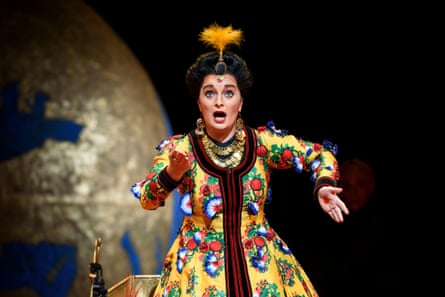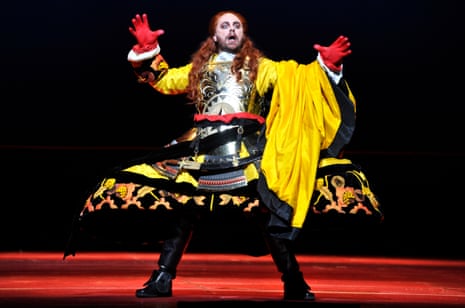It’s 26 years since Mitridate first stamped self-consciously downstage, all canary-yellow silk, shining breastplate and lustrous locks, in Graham Vick’s production of Mozart’s early opera. It was something of a milestone at the time – the Handel revival hadn’t yet worked up its full head of steam, and it was still a relatively novel idea that an overlong, over-serious opera by a callow 14-year-old composer, following all the mid 18th-century conventions, could be presented seriously and stylishly for a late 20th-century audience. The tropes Vick settled on have been reused so many times that they have lost their novelty – these big expanses of bold poster-paint colour were last seen in ENO’s Pirates of Penzance, an opera sending up operas like this. And the older, wiser Mozart would write arias that were less obviously difficult, and fewer of them: Mitridate is very long. But in this often very fine performance, with the Royal Opera Orchestra energised by period specialist conductor Christophe Rousset, it is worth it.

The first things you notice – and the last – are Paul Brown’s costumes. Aspasia, the princess desired by King Mitridate and both his sons, glides around in a surreally exaggerated panniered skirt at least six feet across. If this were a David Lynch film its two sides would rise like curtains to reveal, instead of legs, another stage, and another, tiny production of Mitridate. In sheer width she outguns the men, pseudo-Japanese warriors in brightly coloured yet more modestly panniered outfits and half armour – part highly polished armadillo, part Quality Street. If it came to it, Albina Shagimuratova would win in the vocal stakes, too: there’s some loss of intensity in her quiet third-act aria, but the firework numbers are superbly full-toned.
Countertenor Bejun Mehta, dressed as the green praline triangle, runs her close as bad brother Farnace; good brother Sifare, dressed as the coconut one nobody likes, is a little dull by comparison, though Salome Jicia makes lovely work of her horn-accompanied aria. The lucky hazelnut-in-caramel is the Roman leader Marzio, in which role tenor Rupert Charlesworth is a late stand-in, as he was in ENO’s Partenope last autumn. Once again he steals his scenes.
Michael Spyres’s tenor has sounded more mellifluous in less arduous roles than Mitridate, but he’s equal to Mozart’s two-octave leaps, and his furious vengeance aria is especially impressive. Posing like a dancing girl carved on the wall of a far-eastern temple, Lucy Crowe brings presence to the foreign princess Ismene, and sings beautifully. Radio 3 is broadcasting the performance on 8 July, but it should really be seen as well as heard.
At Royal Opera House, London, until 7 July. Box office: 020-7304 4000.


Comments (…)
Sign in or create your Guardian account to join the discussion